#Edison Research
Text
Trump Secures Victory in New Hampshire Primary, Posing Challenges for Rival Haley
The 2024 United States presidential election season is underway, and New Hampshire recently hosted its crucial primary, marking a pivotal moment in the race. In a swift announcement by the Associated Press, former President Donald Trump emerged as the Republican winner, further solidifying his dominance within the party. This article delves into the New Hampshire primary results, analyzing the…

View On WordPress
#2024 Presidential Election#Abortion Rights#Associated Press#Biden&039;s Write-in Campaign#Campaign Developments.#Campaign Dynamics#Candidate Strategies#Democratic National Committee#Democratic Victory#Donald Trump#Edison Research#Election Dynamics#Election Implications#Election Narratives#Election Night Drama#Election Results#Electoral Landscape#Electoral Process#Exit Polls#Haley&039;s Campaign#Iowa Caucus#Joe Biden#New Hampshire Ballot#New Hampshire Primary#Nikki Haley#Political Challenges#Political Controversies#Political Landscape#Political Rivalry#Republican Nomination
0 notes
Text
Remember that one fan theory I wrote about Alastor having a rivalry with Thomas Edison in the 1920s? Well, I decided to do a bit more research; it turns out that, not only was I right, but Edison really hated radio. He loathed it so much that he wrote not one, but several articles railing against the "radio fad" in 1926, to the point where an anonymous person wrote "letters to the editor" to argue with Edison.
Gee, I wonder who it could be doing that in the Hazbin-verse? /s
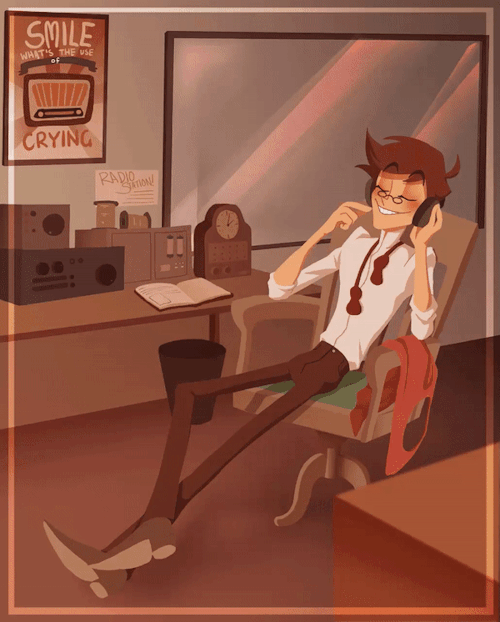
GIF and art originally by karumkin on Twitter/X (2019).
There was also a slew of increasingly aggressive telegrams sent back-and-forth between Edison and radio proponents, with Edison penning thinly-veiled insults that offended even mild critics of the "Wizard":
"The radio is a commercial failure, and its popularity with the public is waning. Radio is impractical commercially, and ethically distorted, and is is losing its grip rapidly in the market and in the home. There is not 10% of the interest in the radio that there was last year.
Radio is a highly-complicated machine in the hands of people who know nothing about it. No dealers have made any money out of it. It is not a commercial machine, because it is too complicated. Reports from 4,000 Edison dealers who have handled radio sets show that they are rapidly abandoning it; and, as for its music, it is awful.
I don't see how they can listen to it. Thousands of people have signed a petition asking that sopranos be kept off the air. Of course, most of them don't know that the soprano voice distorts the radio. The phonograph is coming into its own because people want good music. The fact is that the radio never had a high peak of popularity.
In towns where 25 or 30 dealers were handling radio sets, only one or two are now handling them. A farmer 5 miles from town buys a radio, perhaps on the installment plan. A wire becomes loose. The dealer has to arrange to fix it. This happens time and time again. The business becomes unprofitable for the dealer to engage in. He does not make any money out of it. None of them has. They are giving it up as fast as they can. It is not a commercially successful machine, because it is too complicated.
Static is awful, and the difficulties of tuning out--and now, they're stealing each other's wavelengths! It is too bad that the radio has to be too complicated. It was a big and interesting thing, and the people responded to it, but they want good music, and they found it is not to be had on the radio. That is why the phonograph is reclaiming its own."
Quote from "Edison and Radio", Radio News, December 1926, "in which the Editor takes issue with Mr. Edison's claim that radio is a failure; yet it is pointed out that the radio industry owes Edison a great debt; wherein facts are figures are given to show that radio is on a steady increase; granting that neither radio, nor the phonograph, is yet perfect; how the interest in radio is steadily increasing, and radio dealers are now making good money":
"Since the publication of the famous interview with Mr. Edison, the press, and particularly the radio press across the entire country, has been more or less agitated...I do believe that Mr. Edison has not been recently in-touch with radio sufficiently to appreciate fully the tremendous advances that have been made. Mr. Edison is a busy man, and a tremendously busy inventor. It would be well-nigh impossible for him to be in-touch with all of the various commercial phases of radio all over the country; and, like other executives, he obtains his reports from his subordinates, and such reports often as not may be highly colorful, and even wrong...[thus, the radio industry is unwilling to accord Mr. Edison anything]...as to Mr. Edison's remarks, the statements that follow are facts, which can be checked up by anyone who is unbiased."
Imagine Alastor and Vox with "Stayed Gone" in Episode 2, and Alastor and Lucifer with "Hell's Greatest Dad" in Episode 5, but happening entirely over letters and telegrams, because mass media and television didn't exist yet. The closest musical numbers would likely be "Farmer Refuted" and "Your Obedient Servant" from Hamilton.
Per the book The Wizard of Menlo Park: How Thomas Alva Edison Invented the Modern World by Randall E. Stross:
Page 276: "[Edison's] phonograph business faced a challenge in the 1920s unlike any that had come before: the advent of commercial radio stations, and the wide availability of free music broadcasts and other entertainment. By the end of 1921, an estimated 1 million listeners had access to radios, and listened to programs broadcast from the Eastern seaboard. A single station in Roselle, New Jersey, which offered the voices of operatic stars among its musical programs, had a broadcast range of a thousand miles, covering New England and the mid-Atlantic states, and reaching as far west as Missouri. A contemporary newspaper account explained to readers not yet acquainted with the phenomenon that those who owned radio sets could enjoy entertainment that was 'literally as free as the air'. Charles and Theodore Edison [proposed a combination phonograph-radio]...their father need not feel slighted because the vacuum tube, a key component of the radio set, was a modern descendant of Edison's experimental work on the incandescent lightbulb. Edison did feel slighted, however; such, at least, was the opinion of Thomas Cowan, a former Westinghouse employee...[who conducted experiments in radio broadcasts with the aid of a phonograph Edison was willing to loan him in 1921]. Cowan had several conversations about radio with Edison, who became upset and recalled the loaner when he heard the Westinghouse broadcasts...[Edison's sons were embarrassed, humiliated]."
"Edison calls radio a 'failure for music', thinks phonograph will regain its own": The New York Times, 23 September 1926. Underlining the usefulness of radio for purposes other than musical programs, Edison did tune in to a radio broadcast of the Dempsey-Tunney fight in 1926, which he was too deaf to hear. He had to rely on family members [usually his wife, Mina] to summarize what had transpired at the end of each round.
"Radio satisfactory on bout, Edison says": The New York Times, 24 September 1926. Defending the quality of musical broadcasts, the radio industry offered expert testimony to rebut Edison's claims [in the next week's newspaper]. See: "Broadcasters disagree with electrical wizard", The New York Times, 3 October 1926.
The "radio fad": A few months later, [after much outcry from the radio industry], Edison was willing to grant that radio might not disappear, but he had a new criticism: listeners' aesthetic sense would be damaged. "Undistorted music, in time, will sound strange to those brought up on radio music," he predicted, "and they will not like the real thing." See: "Thomas A. Edison sees a menace for music in the radio", Musician, January 1927.
"Edison's fears [about the Edison Company not succeeding in the radio business] were realized, though it had been Edison's intransigence (refusal to change one's views) that put the company at such a great disadvantage as a late entrant...on 9 October 1929, Charles Edison prepared a report for his father that showed a loss of $1.3 million due to start-up costs for the [Edison] radio...he could not know that, two weeks later, the stock sell-off would begin with Black Thursday, on 24 October, followed by Black Monday and Black Tuesday...a few days later, Thomas A. Edison, Inc., announced that it would cease producing [music] records [altogether], and refit the factory for the production of radios. The announcement was accompanied by a mention of regret, as the phonograph was 'one of Mr. Edison's favorite inventions'."
"An employee reported observing Harvey Firestone tearfully explaining to Edison that the collapse of business due to the stock market crash of 1929, and the Great Depression, meant that he could no longer continue to financially support Edison's laboratory. Edison was heard, sneering, 'He's a Goddamned lightweight.'" ("I saw your fiasco on the picture show, and I just couldn't resist. What a performance! Why, I haven't been that entertained since the stock market crash of 1929, hahaha! ...so many orphans.")
Edison's death at the age of 84 on 18 October 1931 was also, ironically, commemorated through radio broadcasts: "[The next] night, two radio networks, the National Broadcasting Company (NBC) and the Columbia Broadcasting Company (CBC), jointly broadcast an 8-minute tribute that ended on the hour, when listeners were asked to turn out the lights. The White House did so, and much of the nation followed, more or less together, some a minute before the hour, others on the hour. On Broadway, 75% of the electrified signs were turned off briefly. Movie theaters went dark for a moment. Everything seemed connected to Edison: the indoor lights, the traffic lights, the electric advertising, everyone connected via radio, which Edison now received credit for helping to 'perfect'. In the simple narrative that provided inspiration for posterity, one man had done it all..."
Some numbers provided for how much radio was making:
1922: $46.5 million (~$860 million in 2024)
1923: $120 million (~$2.2 billion in 2024) (156% increase)
1924: $350 million (~$6.3 billion in 2024) (186% increase)
1925: $449 million (~$8 billion in 2024) (27% increase)
1926: $520 million (~$9.1 billion in 2024) (14% increase)
Overall, per another source:
1922: $60 million (a little more than the previous statistic)
1929: $842.6 million
From here, we can tell the biggest gain was in 1923-1924. Per another source: "Total cost was about $120.00 to buy a new radio in 1926; in today's money, that is about $1,500 to own a radio." That would mean that 7.6 million radios were sold by 1926; an impressive feat, considering that the United States only had a population of a little over 117 million people at the time.
Percentages of United States households with radios:
1925: 19% (5 million households)
1929: 35-40% (200% increase)
1930: 12 million households
1939: 28 million households
The number of licensed broadcast stations surged from just 5 in 1921 to 500 by 1924, per yet another source. In the early years, household radio ownership was highest in the Northeast and on the West Coast. In large sections of the South, Midwest and Great Plains, stations and radio sets were scarce. However, there were notable exceptions.
There were 732 radio stations total across the country by 1927, and the average radio was on 2 hours and 25 minutes per day. People who couldn't afford radios purchased them on installment loans, through which the full price of a new radio could be paid over time. Radios had even more advertisements for washers, dryers, and refrigerators, causing people to use even more merchant credit and installment loans to purchase these shiny, new technological devices.
However, radio sales also took a hit with the Great Depression, as average income levels fell from $3,270 per year in 1920 ($53,300 in 2024), to $2,300 per year by 1929 ($41,500 in 2024), then to $1,500 per year by 1932 ($35,500 in 2024). However, buying a radio also became cheaper, dropping from a costly $200 ($3,200 in 2024) in the early 1920s, to just $35 ($630 in 2024) by 1929-1930.
By the time Alastor died in 1933, 3.6 million radio sets were sold that year alone. By the mid-1930s, 67% of American households had radio sets, and by 1939, about 80% of Americans—over 100 million people—owned radios. Radios were in almost every house, and some Americans even had radios in their cars. The Golden Age of Radio lasted from the 1930s to the 1940s, before being eclipsed by television in the 1950s. Radio hosts went from being paid $10 per broadcast in 1921 ($180-200, 1-2 hours per night, 3-4 nights a week, for a weekly salary of $720-800; monthly salary, $2,900-$3,200; annual salary, $34,800-$38,400; modern-day annual salary range for a radio show host is $30,000-100,000, depending) to making triple-figure salaries in the later 1930s.
Another source lists the following salary ranges for radio hosts:
$2,500-2,700 a year to be an announcer in 1927* (~$45,000-$48,000 range in 2024)
$2,400 a year to be a dramatic director (~$43,000 in 2024)
$4,000 a year to be a program director (~$72,000 in 2024)
New Orleans' first radio broadcast was on 31 March 1922, with WWL. The station wasn't started as a commercial one; but rather, "more of an experiment, started as an interest in wireless communication picked up nationally". The station did not go commercial until 1929, meaning that Alastor also probably had at least one other side job.
Also see:
"Early Radio Announcers Invented Their Profession in the 1920s"
"The History of the Radio Industry in the United States to 1940"
"'A Godlike Presence': The Impact of Radio on the 1920s and 1930s" by Tom Lewis
American Babel: Rogue Radio Broadcasters of the Jazz Age by Clifford John Doerksen (see excerpt here)
Race and Radio: Pioneering Black Broadcasters in New Orleans by Bala James Baptiste (Note: The earliest Black broadcast in New Orleans was in 1945, meaning Alastor was white-passing.)
"Golden Age of Black Radio - Part 1: The Early Years" (Note: The first Black radio announcer, Jack L. Cooper, hosted in 1929.)
"How African Americans Entered Mainstream Radio" by Bala James Baptiste, the author of Race and Radio: Pioneering...
#hazbin hotel#alastor#hazbin hotel alastor#hazbin alastor#alastor hazbin hotel#alastor hazbin#alastor the radio demon#radio demon#thomas edison#long post#i did a lot of research for this okay
141 notes
·
View notes
Text
#this is for really important research purposes guys#trobed#abed nadir#troy barnes#community#community tv show#community tv#jeff winger#britta perry#annie edison#shirley bennett#troy and abed#nbc community#six seasons and a movie
185 notes
·
View notes
Text
hc that abed uses annies ao3 account . annie bookmarks the pages into her browser because she can sort them into folders so all of the works and bookmarks are inspector/reggie fics and character analysis essays
#shui talks#nbc community#abed nadir#annie edison#maybe a few kickpuncher/punchkicker fics for the sake of trope research (enemies to lovers)
24 notes
·
View notes
Text
*ignoring the fics I've started writing and haven't updated in months* what if I start writing an enemies to lovers Annie Edison x Annie Kim fic?
Plot idea currently is that both Annie's are in a debate club/class but they're always on seperate teams. And they absolutely hate each other. They want their team to win and be the best, so they keep constantly trying harder and harder to win. Sometimes Annie Kim's team wins, and sometimes Annie Edison's team wins.
Annie Kim's team is the most recent winner, so the other Annie is going to do whatever the hell she can to win next time. So she stays in the library until late and, when finally heading back home, she hears crying in an empty classroom. Opening it up, she sees Annie Kim inside.
Hesitantly Annie Edison walks inside and asks the other Annie what happened. Annie Kim admits that she quit her debate team because they've made her feel uncomfortable after they found out she's a lesbian. Annie Edison ends up suggesting that Annie Kim joins her debate team, and together they can defeat the jerks who made her quit. Annie Kim agrees.
Initially they have a really tough time doing this. The two have different ways of studying, and they keep getting into petty arguments. They think maybe it was a bad idea to team up.
Still, they continue to try and slowly some progress is made. The two Annie's have an easier time preparing. The two start hanging out more often, even outside of debate preparation. And Annie Edison is surprised to find she actually enjoys hanging out with Annie Kim.
They talk more and more, and hang out more and more, until the two start really looking forward to hanging out. Feelings start developing.
There's another debate, and they're going against the team Annie Kim was on. The two crush them, and win the debate.
Then they kiss, and become girlfriends!
#vague little plot summary and there definitely would be more but annie kim x annie edison in my brain again#also I'll fully admit i know almost nothing about how debate clubs work so ignore any possible inaccuracies for now. I'll do more research#when i actually write this#if i actually write this#i just think itd be cool to write something about them#annie edison#annie kim#nbc community#lesbian annie edison
26 notes
·
View notes
Text
#troy barnes#trobed#community movie#six seasons and a movie#nbc community#abed nadir#jeff winger#annie edison#britta perry#shirley bennet#i finally have polls and can do important research
121 notes
·
View notes
Text


My liege. Screenshots. Now.
#soulbonds don’t look#it’s for research I prommy#Mephistopheles#Fate/Grand Order#F/GO#caster.txt#my posts#photo post#no I won’t fully crop out Edison’s name. I’m being disrespectful
1 note
·
View note
Text
X-Ray Image Taken By Nikola Tesla (1896)
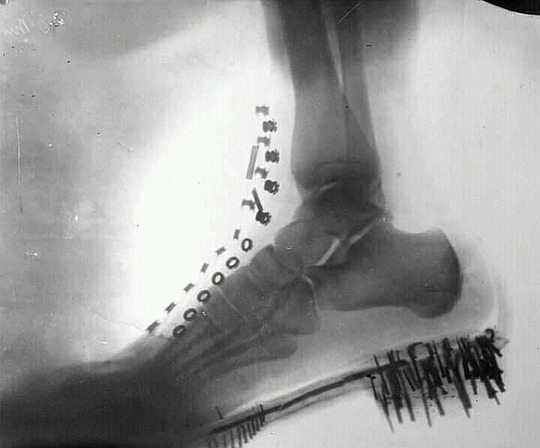
Though not widely known, Nikola Tesla spent a great deal of time intensively researching X-rays, publishing his results during the period between March 11, 1896 to August 11, 1897. He also gave a lecture on April 6, 1897 presenting designs of several different devices that could generate these powerful rays. During this lecture, he shared similar data and conclusions from his earlier experiments with Crookes tubes in 1894. Crookes tubes were invented by British scientist William Crookes in order to study electrical discharges in vacuum tubes. During Tesla’s experiments in 1894, he observed that some of the tubes that produced only feeble visible light had more effect on photographic plates than tubes which were brighter. Since it was obvious that there must be some kind of energy coming from the tubes with feeble light, and their properties were still unknown, Tesla used the term “radiant matter" to describe these radiations. With these tubes, Tesla produced some of the first X-ray imaging, which he called “shadowgraphs,” due to their dark nature, but still did not realize the importance of these radiations. To him, the photographs taken seemed to be spoiled due to unaccountable marks and defects. In March of 1895, a fire broke out in his laboratory, destroying practically all of his equipment and experimental data to date. It took several months before he could resume his work, and in the meantime, a German scientist named Wilhelm Röntgen made his X-ray discovery in the same year (December, 1895). Roentgen first detected the radiation by accident in his experiments where he was testing whether cathode rays emitted from Crookes tubes could pass through glass, and or other solid objects, but was astonished to find that the rays emitted would pass through thinner objects and leave shadows of the more solid objects behind (such as with skin and bones). When Tesla heard this news, it was immediately obvious to him what had been problematic in his laboratory work. Realizing and regretting that he had missed out on making a major scientific discovery, Tesla would say, “I realized that my guiding spirit had again prompted me and that I had failed to comprehend his mysterious signs.” He repeated Röntgen's experiments, and came to much better results than Röntgen and others since he had his newly developed Tesla Coil. With this apparatus, he immediately realized the importance of high voltages for producing powerful rays and suggested using his newly developed single-terminal tubes and connecting them to the secondary coil of the transformer. In 1896, Röntgen acknowledged Tesla’s discoveries and in a lecture before the Physical Medical Society in Wurzburg, Germany, discussed the advantage of using Tesla’s high-frequency transformer in generating X-rays. Tesla would also become one of the first scientists to point out the harms of these rays and developed safer ways to utilize them for medical use. Methods we still use today. On the other side of town, others like Thomas Edison thought these newly discovered rays could cure the blind. Many patients who were experimented upon starting showing terrible illnesses, one being his assistant who later had to have both arms amputated. Edison was quoted in an interview saying, “Don’t talk to me about X-rays…I am afraid of them.”
Nikola Tesla would later give all credit to Röntgen for the discovery, and throughout the next few years, produced some of the best X-ray imaging that even Röntgen praised. In a letter to Tesla, Röntgen wrote, “Dear Sir! You have surprised me tremendously with the beautiful photographs of wonderful discharges, and I tell you thank you very much for that. If only I knew how you make such things!”
#nikola tesla#science#history#x ray#X-rays#technology#invention#medical#electricity#quotes#ahead of his time#ahead of our time
159 notes
·
View notes
Text
Technoblade is listed to receive the Courage Award at the Sarcoma Foundation of America’s 20th annual fundraising gala, Stand Up to Sarcoma, which will be held on September 28, 2022, at the Edison Ballroom in New York City.
Here is a link to the article.


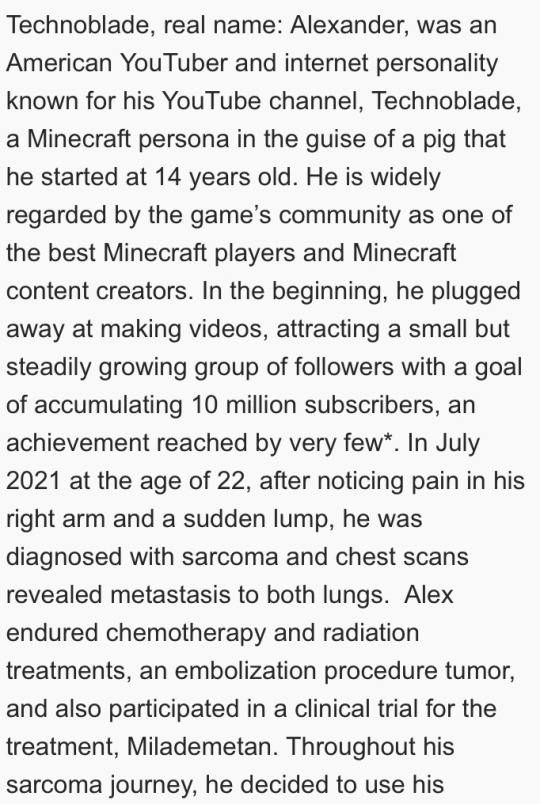
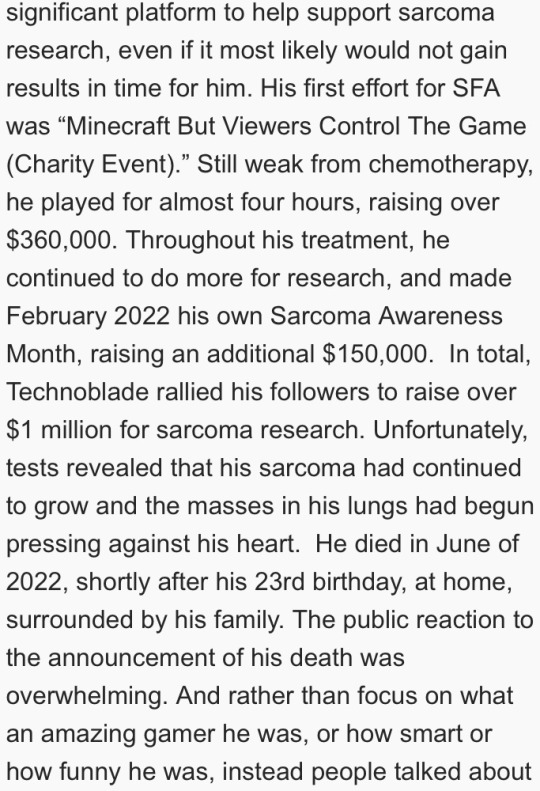
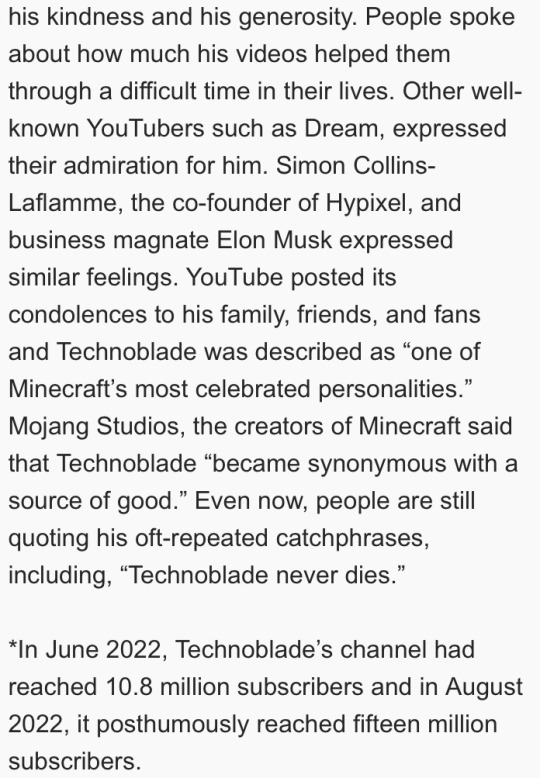
[Image ID:
A series of screenshots showing the listing for this year’s Courage Award from the Sarcoma Foundation of America. It reads:
“Courage Award honorees illustrate, through their personal efforts and actions, sarcoma advocacy. These individuals are patients, survivors, caregivers, and advocates who inspire others by using their platform on behalf of sarcoma patients and survivors to create hope and a better life for the sarcoma community. Many do not think they have done something special but who have inspired others and are making a difference for sarcoma patients and their families. The Courage Award honors patients who have demonstrated strength and perseverance in their sarcoma diagnosis.
Technoblade
*attached is, instead of a photo of the honoree like with other award listings, Techno’s YouTube icon.*
Technoblade, real name: Alexander, was an American YouTuber and internet personality known for his YouTube channel, Technoblade, a Minecraft persona in the guise of a pig that he started at 14 years old. He is widely regarded by the game’s community as one of the best Minecraft players and Minecraft content creators. In the beginning, he plugged away at making videos, attracting a small but steadily growing group of followers with a goal of accumulating 10 million subscribers, an achievement reached by very few*. In July 2021 at the age of 22, after noticing pain in his right arm and a sudden lump, he was diagnosed with sarcoma and chest scans revealed metastasis to both lungs. Alex endured chemotherapy and radiation treatments, an embolization procedure tumor, and also participated in a clinical trial for the treatment, Milademetan. Throughout his sarcoma journey, he decided to use his significant platform to help support sarcoma research, even if it most likely would not gain results in time for him. His first effort for SFA was “Minecraft But Viewers Control The Game (Charity Event).” Still weak from chemotherapy, he played for almost four hours, raising over $360,000. Throughout his treatment, he continued to do more for research, and made February 2022 his own Sarcoma Awareness Month, raising an additional $150,000. In total, Technoblade rallied his followers to raise over $1 million for sarcoma research. Unfortunately, tests revealed that his sarcoma had continued to grow and the masses in his lungs had begun pressing against his heart. He died in June of 2022, shortly after his 23rd birthday, at home, surrounded by his family. The public reaction to the announcement of his death was overwhelming. And rather than focus on what an amazing gamer he was, or how smart or how funny he was, instead people talked about his kindness and his generosity. People spoke about how much his videos helped them through a difficult time in their lives. Other well-known YouTubers such as Dream, expressed their admiration for him. Simon Collins-Laflamme, the co-founder of Hypixel, and business magnate Elon Musk expressed similar feelings. YouTube posted its condolences to his family, friends, and fans and Technoblade was described as “one of Minecraft’s most celebrated personalities.” Mojang Studios, the creators of Minecraft said that Technoblade “became synonymous with a source of good.” Even now, people are still quoting his oft-repeated catchphrases, including, “Technoblade never dies.”
*In June 2022, Technoblade’s channel had reached 10.8 million subscribers and in August 2022, it posthumously reached fifteen million subscribers.”
End ID]
2K notes
·
View notes
Text
creepy/messed-up history facts
the man in the booth across from lincoln was named major henry rathbone, and after booth fired the shot, rathbone tried to tackle him to the ground, but booth sliced rathbone in the arm with a dagger. after that night, rathbone was never free of guilt. he suffered from stomach ailments to heart palpitations, and on december 23rd 1883, he attacked and killed his wife clara, and attempted to kill himself. he spent the rest of his life in a mental institution.
in 1494, sailors returning from the new world brought with them massive outbreak of syphilis, which spread through an entire french army, and with no antibiotics to counteract it, the disease spread unchecked. the skin on victims' faces would essentially rot away from the grisly ulcers. in some cases, the noses, lips and other body parts of the affected people were essentially gone.
in 1890, thomas edison, using wax cylinder, produced a line of baby dolls. they had wooden bodies, procelain heads, and miniature phonographs in their chests. the phonographs would play back recordings of young women reciting nursery rhymes like "hictory dickory dock," and "now i lay me down to sleep." (here's the audio of them x)
dentures used to be made from the teeth of dead soldiers. they were ivory base plates with real human teeth attached, a lot of these were sold to dentists by scavengers looting corpses from the battle of waterloo. the dentists would boil the them down, cut off the roots, attach them to ivory plates, and sell them.
in 1929, a pair of scientists at princeton university wanted to test and understand how the auditory nerve percieves sound, and their test subject was an alive cat. they cut out part of its brain and attached one end of a telephone wire to its auditory nerve and the other end to a reciever. weirdly enough, many researchers think this helped lead to the development of cochlear implants. but the cat was killed after the scientists wanted to see if it worked on a dead cat.
in 1726, mary toft told doctors that she gave birth to rabbits, and doctors were fully convinced until they found pieces of corn inside the stomach of one of the rabbits, proving that it hadn't developed inside her womb. she instead was manually inserting the rabbits to make the delivery look as realistic as possible.
it was believed that babies under the age of 15 months couldn't feel pain, so doctors would instead use muscle relaxers that had a paralytic effect to stop the baby from moving. this essentially meant they couldn't move or cry but they could still hear, see, and feel everything that was done to them. this was accepted up until 1980s
there was a tiger in india named man-eater of champawat who became dependent on human flesh, which at the turn of the 20th century inflicted a seven-year reign, killing 436 men, women, and children. she was eventually killed in 1907.
there was a book called "how the mail steamer went down in mid atlantic, by a survivor," which tells the story of an unnamed ocean liner that sinks in the atlantic. the protagonist is a sailor named thompson, who grows concerned over the lifeboat shortage, and sure enough the liners collides with a small sailing ship in a fog. as the ship sinks, only 200 of the 700 people on board survive. the second novella "the wreck of the titan: or, futility" by morgan robertson, follows the fictional ocean liner titan, which hits an iceberg in the north atlantic and sinks. like the titanic, the titan was described as the largest ship afloat at the time, both ships had a shortage of lifeboats, and the titan was dubbed "unsinkable." when the accident occurred, roberston simply said he was knowledgabe about maritime operations, saying "i know what i'm writing about, that's all."
some books created in the 18th and 19th century were bound in real human skin which was called anthropodermic bibliopegy. most of these books that were bound with human skin instead of animal skin were mostly based on anatomy or erotica.
during the battle of ramree island, which was fought between january and february 1945, japanese soldiers were cornered by english troops seeking to conquer burmese island of ramree, forcing japanese troops to cross 10 miles of swamp. the japanese soon began to suffer the effects of tropical diseases, but the presence of large numbers of scorpions, tropical mosquitoes and thousands of saltwater crocodiles, the world's largest reptiles, was even worse. In its genre. very aggressive beasts that can reach 8 meters in length and weigh more than a ton. according to some survivors, during the night, they were hunted one by one, in which the crocodiles would ambush them from underneath. and the survivors said the worst part was hearing the screams and the breaking of bones in the dark.
there is a cocodile named gustave (or was if you believe he's dead), a large nile crocodile in burundi who has been rumored to have killed 200-300 people. he's never been captured, but it has been stated that he could be "easily more than 20 feet, and weigh more than 2,000 pounds." he was/is estimated to be over 100 years old, and was/is described as having bullet wounds over his body, and his right shoulder blade was found to be deeply wounded, but they don't know what could have caused it. it's been rumored that he would leave the corpses he killed behind. in 2019, an article revealed he was killed, but there's no photographic evidence which leaves people doubting it's true.
147 notes
·
View notes
Text
I finally have time to talk about Lone Trail. I will be focusing on its depiction of science, technology and its progress. Will get a bit political, but funnily enough less than I imagined.
The thing that called my attention most in Lone Trail were the discussions on the nature of scientific progress. This is a theme that’s dear to me and the stuff I research about. It’s easy to think of scientific progress like an inevitable march forward, like an escalator. After all, we are much richer than we were before, right? Go to OurWorldInData dot org to play around with economic statistics in time – make sure to check the World GDP chart, from year 0 to 2000 and see it taking off like a rocket from year 1700.
What kind of Uncle Ted fan or neoluddite would go against that? Haha…hah…
Truth is that, although its effects are there, it’s not a clear if this is the little, neat process techbros want us to believe. It’s new and produces more, therefore it’s good, right? I could be writing this as a new wave of AI-generated NFTs pollute my algorithm.
That’s what makes the storytelling in Arknights so effective: it mashes together fantasy and sci-fi to really tell stories on the role of beliefs, technology, science and religion. The Rhine Lab saga is definitely an exploration of technology, with focus on the equivalent of the United States. During the period before the First World War, 1870-1913 (which is the one that Arknights draws most from), the world underwent through the so-called Second Industrial Revolution and I’ve read economic historians considering it the most innovative period in human history. I mean, obviously, there is an absolute number of inventions in our current age, but in relative terms 1870-1913 experienced a much larger number relative to the previous one.
The escalator narrative constructs scientific achievements as work of daring people (mostly men, but there were women like Marie Cuire), that combined science and technology to help mankind, like Prometheus giving mankind fire from the gods (in fact, one of these books is even named “Prometheus Unbound”); more than often they have to fight against the establishment. Remember Ignaz von Semmelweis? He just wanted doctors to wash their hands. Even I learned this standard narrative in the university. But that’s not the entire story.
The positivistic paradigm – of a science free of value judgements, made with the power of math – has actually helped build this escalator narrative. In reality, some scientists and scholars are horrible people. Later, I learned that Semmelweis, as much as he campaigned for the right thing, was a very arrogant person, who abused everyone around him, to the point few people went to his funeral.
Narratives focusing on one single hero are easy to sell and the ones building them are always on the lookout. Remember how ten years ago, a lot of people tried to push the narrative Elon Musk was going to create a new industrial revolution? Nowadays he’s just an arrogant loser who keeps dragging on his midlife crisis. The 1880s also had similar people like that, such as Thomas Edison.
Kristen Wright is definitely better than them both, because she is actually an engineering genius. But she’s also just like them, in the sense of unethical experiments, collusion with the military-industrial complex and being an overall superficially charismatic, but rotten to the core person. And she’s surrounded by a lot of people like Parvis and Ferdinand.
Breaking this line of reason, I have to say how much I hate Nietzsche’s ubermensch and master-slave morality, I hate Great Men theory, I hate Ayn Rand; these people are sheep who think themselves wolves. And before you say that Nietzsche didn’t consider himself an ubermensch, well, neither did Parvis and his reasoning was the same. For every person fancying themselves ubermensch, there’s a lot of those whom he’d call untermensch to clean up their messes. You have no idea of how times I stumbled upon people (especially libertarians) that advocate lower barriers to regulations that were written in blood, so that progress can happen quicker. Creative destruction works, as long as some people get “creative” and others clean the “destruction”. Deaths and injuries? Acceptable, just give them a pension (but fight tooth and nail in the court to not do it beyond the barest of the bare minimum, because it’ll lower the shareholder profit in 0.01%). Increase in inequality? Nobody will care in a few years, it’ll make everything cheaper anyway (look up Baumol’s cost disease to see how wrong that statement is, without being incorrect). I’m not exaggerating, sometimes the people saying that don’t even bother lacing it in politically correct language.
Because Lone Trail showed it “worked” – Kristen Wright broke off the ceiling over Terra and that will have consequences (especially with Endfield coming closer). The data from her experiments will advance science, the sight of a broken ceiling will inspire artists and prompt politicians to act. Was it worth it? Well, it will depend on who you ask (like, Ifrit or Rosmontis would have strong feelings), but it’s just there now. Serious history isn’t kind on this question as well – many technologies have a lot of transgressions, both legal and ethical, in their supply chain (both the American and Soviet space program come to my mind – guess who helped them); the difference between an entrepreneur and a criminal are contextual, because both are finding new opportunities of profit and both interlock frequently.
In the end, anyone can put an equation that has its uses, not mattering if it’s a good person or not. But that is no excuse to find good ethical practices. Silence saw everything with her own eyes and I’m really glad she’s leading the initiative for a more ethical science in Columbia – especially because people who are willing to break moral rules tend also to be willing to break research rules (this is why the “research” made in concentration camps is actually useless, it didn’t respect experimental rules). So I’m really glad for the Arknights writers for understanding these nuances and communicating them to the audience through one of the best stories of the game.
55 notes
·
View notes
Text
Part 2 of Carlotta, Piangi & the cake
~Consequences
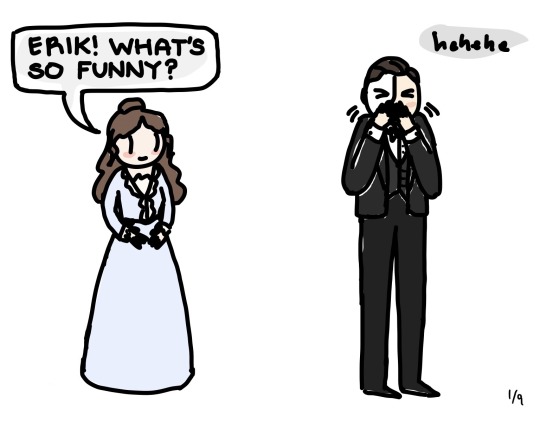



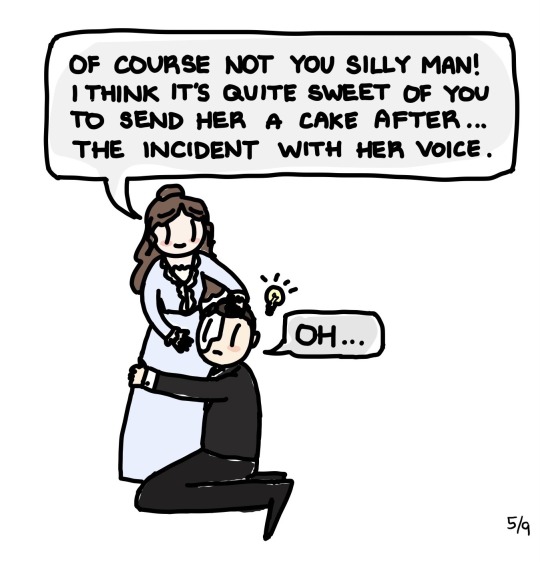

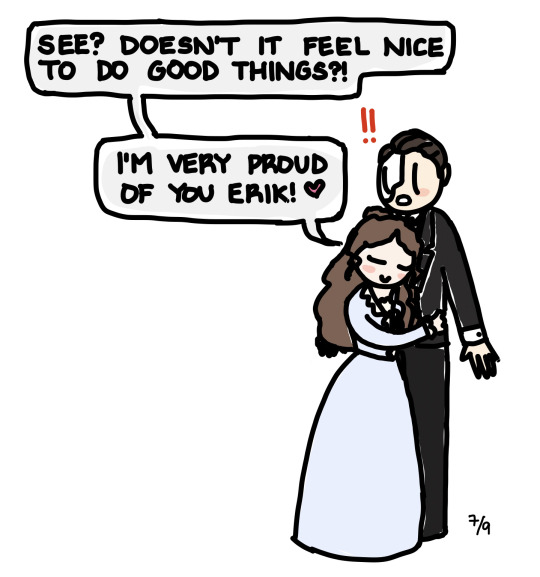

😭😭😭 Piangi is gonna get diabetes

🎶 Notes 🎶
- once again, I forgot to wait for the poll to end lmao
- Christine is truly naive and trusting? Or purposely not asking the important questions so she doesn’t have to get out the spray bottle with lemon water for naughty Erik which makes him cry and hiss 😖😾😾
- Erik sets new record for going from “oh no she hates me” to “wow yes I am a Good Person” in 0.5 sec
- I’m remembering now that the new “electric light” is mentioned at the during the auction that takes place years after the events of poto so I guess Erik invents the lightbulb in panel #5 sorry Thomas Edison and/or Nikola Tesla 😣
EDIT: @night-unfurls-its-splendour in anticipation of u researching the actual dates I went back and looked it up…so apparently the lightbulb was invented in 1879 (according to Edison’s camp). If poto takes place in 1881 then my use of the lightbulb in panel 5 is not an anachronism haha
- pls pray for Piangi’s blood sugar level 🙏🙏
- this was Carlotta’s cake btw if u didn’t read the previous part

#poto#the phantom of the opera#comics and doodles#poto doodles#Erik: *does something bad*#also Erik: plsss Christine don’t hate me for the bad thing I did 😭🙏🙏🙏#good thing Piangi ate the entire cake tho so Christine will never know the truth 🥲
160 notes
·
View notes
Text
given the Discourse, i couldn't not post this article.
Extremism experts and LGBTQ advocates warned that removing merchandise could be seen as a success by anti-LGBTQ extremists and violent protesters which could lead to copycat behavior threatening the already marginalized community.
"I think this will embolden alt-right actors, who now are going to believe that with social media campaigns and targeted actions against retailers that they can proceed in limiting visibility of LGBTQ people," said Sophie Bjork-James, a professor at Vanderbilt University, who researches the white nationalist movement, in an interview.
"Target's giving into this," said Victor Asal, a professor at Albany and extremism researcher. "Other extremists will say 'hey, that's a great idea. We should do that.'"
Michael Edison Hayden, a senior investigative reporter at the Southern Poverty Law Center, believes extremists are making calculated efforts to redefine LGBTQ+ Pride as a "toxic" or dangerous thing.
Bomb threats, he said, are intended to scare the community and supporters into silence.
National LGBTQ+ organizations, including Family Equality, GLAAD, GLSEN, The Human Rights Campaign, and more are calling on Target and all businesses to stand up against anti-LGBTQ+ extremism.
"When values of diversity, equity and inclusion are tested, business must defend them unequivocally," the organizations said in a joint statement.
191 notes
·
View notes
Text
I just added eleven more texts, plus two archives of old entertainment magazines, to my list of vaudeville research. At some point "this analysis of film censorship will include a brief overview of vaudeville" became "I am going to be totally focused on vaudeville censorship for months and that's just where I'm at now."
I am neck-deep in Variety Magazine articles from 1905, and we just can't get to Joseph fucking Breen and Will Hays until I yell about B.F. Keith and E.F. Albee. And then also Thomas Edison.
91 notes
·
View notes
Text
i wish to do some research,,
#please tell me in the replies/reblogs ur reasoning#i love polls....#jrwi#jrwi riptide#just roll with it#just roll with it riptide#jrwi spoilers#jrwi riptide spoilers
83 notes
·
View notes